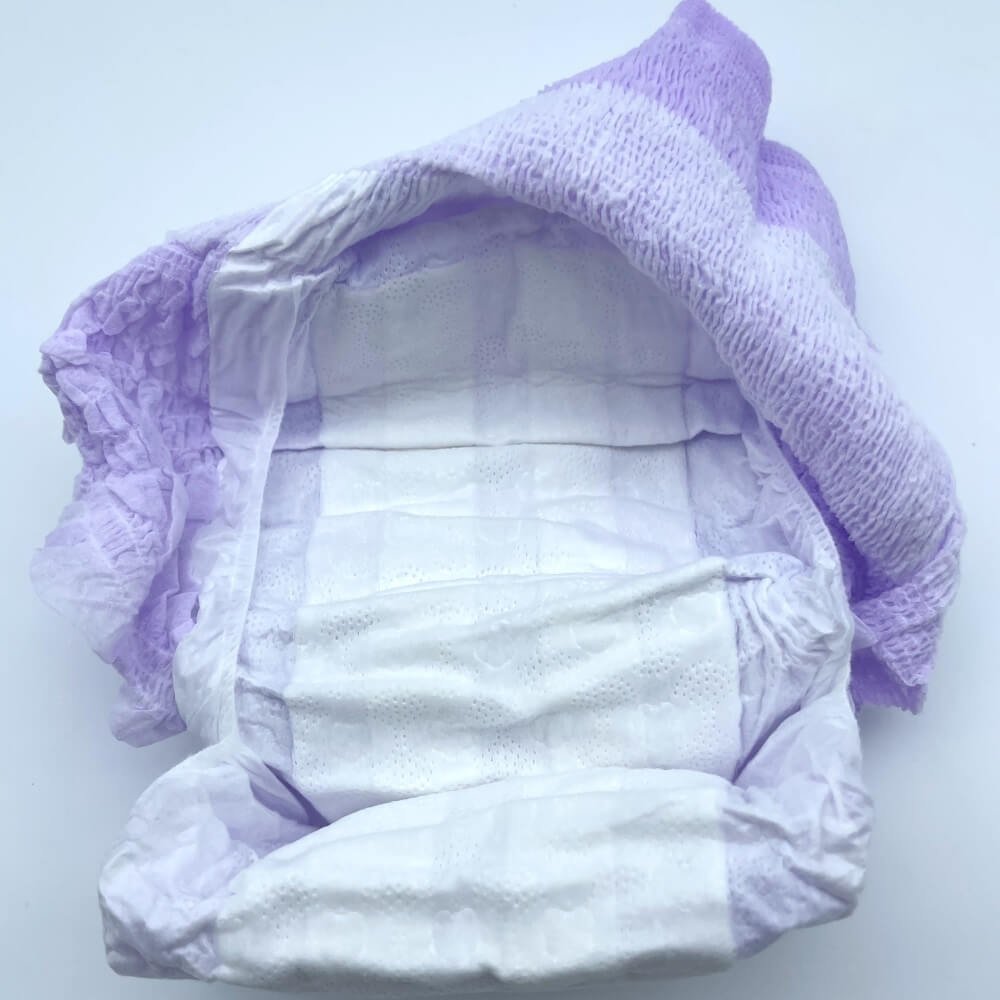Adult period diapers, a significant advancement in personal care, provide a sense of comfort and dignity to those in need of extra support during their menstrual cycle. This article delves into the intricate manufacturing process of these essential products, focusing on the materials, designs, and technologies that enhance their effectiveness. With a growing consumer base and a heightened focus on health and environmental standards, the industry is evolving, pushing the boundaries of comfort, functionality, and sustainability.
Materials and Technology
Materials Used in Adult Period Diapers
The manufacturing of adult period diapers involves a selection of specialized materials designed to offer optimal performance and comfort. Key components include:
- Супервпитывающий полимер (SAP): SAP is crucial for its high absorbency capabilities, locking in moisture and preventing leaks.
- Пух Целлюлозы: Derived from wood cellulose, fluff pulp forms the core of the diaper, enhancing its absorbency and stability.
- Non-Woven Fabrics: These fabrics are used for the diaper’s top sheet and back sheet, providing softness, strength, and breathability to prevent skin irritation.
Manufacturers carefully select these materials not only for their functional properties but also for their safety and skin-friendliness, ensuring that the diapers are gentle on sensitive skin and effective in managing menstrual flow.
Technological Innovations in Diaper Manufacturing
The production of adult period diapers integrates advanced manufacturing technologies that significantly elevate the product’s quality and user experience:
- 3D Forming Technology: This technology ensures a body-contoured fit, which prevents leaks and enhances comfort.
- High-Speed Assembly Lines: Modern diaper manufacturing employs high-speed assembly lines equipped with precision placement tools to produce large volumes while maintaining consistent quality efficiently.
- Air-Laid Technology: Used for the even distribution of fluff pulp and SAP, air-laid technology helps in creating a thinner, more comfortable diaper.
These technological advancements not only improve production efficiency but also significantly enhance the performance of the final product, ensuring that it meets the needs of users effectively.
Дизайн и комфорт
Features that Enhance Comfort
Adult period diapers are designed with multiple features to ensure maximum comfort for the wearer. These include:
- Breathable Materials: To prevent moisture buildup and maintain skin health, the outer layers of the diapers are made from breathable materials that allow air circulation.
- Elastic Waistbands and Leg Cuffs: These features provide a secure fit that adapts to body movements, preventing leaks and ensuring the diaper stays in place.
- Re-sealable Tapes: High-quality re-sealable tapes allow for adjustments throughout the day without compromising the diaper’s integrity.
These design elements play a crucial role in ensuring a comfortable, discreet, and secure experience, allowing users to maintain their lifestyle without compromise during menstruation.
Design Considerations for Adult Period Diapers
In designing adult period diapers, manufacturers must consider both functionality and aesthetics. Key considerations include:
- Anatomical Fit: Diapers are designed to fit the unique contours of the adult body, ensuring comfort and leak protection.
- Discreetness: Slim profiles and quiet materials are used to make the diapers less noticeable under clothing.
- Skin Health: Materials are selected and tested to prevent irritation and support skin health, which is critical for users who may wear diapers continuously.
These considerations ensure that adult period diapers meet the practical and psychological needs of consumers, offering not just protection but also confidence and peace of mind.
Production Process
Step-by-Step Manufacturing Process
The manufacturing of adult period diapers is intricate and highly controlled to ensure product safety and effectiveness. Here’s a detailed look at the typical production steps:
- Material Preparation: Raw materials such as SAP, fluff pulp, and non-woven fabrics are prepared and tested for quality before use.
- Core Formation: The absorbent core, made from fluff pulp mixed with SAP, is formed using air-laid technology to ensure even distribution and optimal absorbency.
- Сборка: The core is then wrapped with a soft, non-woven fabric that acts as the top sheet, and the breathable back sheet is added. Components like elastic waistbands and leg cuffs are also integrated during this phase.
- Cutting and Shaping: The assembled materials are cut and shaped into the final diaper form using high-precision cutting tools.
- Applying Tapes and Packaging: Re-sealable tapes are applied, and the diapers are folded and packaged under sterile conditions to maintain hygiene until they reach the consumer.
This process is heavily automated and monitored to maintain high standards of quality and efficiency, ensuring that each diaper meets the manufacturer’s specifications and consumer expectations.
Quality Control in Diaper Production Quality
Control is a pivotal part of the manufacturing process for adult-period diapers. It includes several key practices:
- Raw Material Inspection: All materials are inspected upon arrival to ensure they meet required safety and quality standards.
- In-Process Quality Checks: During manufacturing, automated systems and quality control personnel perform checks at various stages to detect and rectify any deviations in real time.
- Final Product Testing: Finished products undergo a series of tests to check for leaks, strength, absorbency, and comfort before they are approved for sale.
These quality control measures are essential to build trust with consumers, ensuring that the products they use are safe, reliable, and effective.
Экологические соображения
Eco-Friendly Practices in Diaper Manufacturing
Manufacturers of adult period diapers are increasingly adopting eco-friendly practices to minimize environmental impact:
- Sustainable Materials: Efforts are being made to source biodegradable and sustainable materials such as organic cotton and bamboo fibers for the non-woven layers.
- Waste Reduction: Advanced production technologies reduce waste by optimizing material usage and recycling excess materials where possible.
- Energy Efficiency: Many factories utilize energy-efficient technologies and processes to decrease the carbon footprint of their production facilities.
These initiatives reflect a growing industry commitment to sustainability, addressing consumer demand for products that are not only effective but also environmentally responsible.
Проблемы и решения
While strides are being made toward more sustainable diaper manufacturing, several challenges remain:
- Biodegradability of SAP: Although super absorbent, SAP is not biodegradable, posing environmental disposal challenges. Research is ongoing to find more eco-friendly alternatives that do not compromise absorbency.
- Recycling Used Diapers: The complex composition of used diapers makes them difficult to recycle. Solutions include developing recycling technologies that can separate diaper components for reuse.
Addressing these challenges is crucial for reducing the ecological footprint of adult period diapers and moving towards more sustainable production practices.
Market Trends
Several factors influence Current Market DynamicsThe market for adult period diapers:
- Aging Population: An increasing elderly population worldwide drives demand for adult incontinence products, including period diapers.
- Growing Awareness: There is a growing awareness and openness regarding menstrual health and incontinence, which is expanding the customer base.
These dynamics are shaping the strategies of manufacturers and marketers, who are continuously innovating to meet changing consumer needs and preferences.
Consumer Preferences and Trends
Recent trends in consumer preferences include:
- Demand for Discretion and Comfort: Consumers increasingly demand products that are not only effective but also discreet and comfortable.
- Preference for Skin-Friendly and Hypoallergenic Products: As allergies and skin sensitivities become more common, consumers are choosing products made from hypoallergenic and skin-friendly materials.
Understanding these preferences is essential for manufacturers aiming to design and market adult period diapers that meet the evolving needs of modern consumers.
Challenges in Manufacturing
Addressing Sensitive Skin Concerns
Manufacturing adult period diapers involves careful consideration of materials and formulations to avoid skin irritation. Key challenges include:
- Chemical Sensitivities: Avoid the use of harsh chemicals and fragrances that can cause allergic reactions or skin irritation.
- Breathability: Ensuring that materials used allow for adequate air circulation to prevent moisture buildup, which can lead to rashes and discomfort.
To address these concerns, manufacturers are increasingly turning to hypoallergenic materials and conducting extensive dermatological testing to ensure their products are safe for sensitive skin.
Баланс между стоимостью и качеством
The cost of production remains a significant challenge in the manufacturing of adult period diapers. Factors affecting cost include:
- High-Quality Materials: Premium materials such as organic cotton or advanced polymers can significantly increase production costs.
- Innovative Technologies: Incorporating advanced manufacturing technologies can be initially costly, though they may reduce long-term expenses through increased efficiency.
Manufacturers must strategically balance these costs while maintaining high standards of quality to remain competitive in the market. This often involves optimizing production processes and sourcing materials more effectively without compromising product integrity.
Regulatory Standards
Compliance with Health and Safety Standards
Adult period diapers are subject to stringent health and safety regulations to ensure they are safe for use. Compliance involves:
- Безопасность материалов: Ensuring all materials are free from harmful substances. This often requires compliance with international safety standards such as ISO and Oeko-Tex.
- Product Performance: Regular testing to ensure products meet specific absorbency and leak protection standards.
Manufacturers must stay updated with regulatory changes and ensure all products meet these standards to maintain market access and consumer trust.
International Regulations for Diaper Manufacturing
Different countries may have varied regulations affecting the import, export, and manufacturing of adult period diapers. Key considerations include:
- Trade Regulations: Understanding and complying with trade agreements and tariffs when exporting diapers.
- Environmental Regulations: Adhering to environmental laws related to production and waste management in different regions.
Navigating these regulations requires a robust legal and compliance framework within manufacturing companies to ensure smooth operations across international markets.
Innovations and Future Outlook
Emerging Technologies in Diaper Manufacturing
The future of adult period diaper manufacturing is being shaped by several emerging technologies:
- Smart Diapers: Incorporating sensors that can indicate when a diaper needs changing, enhancing comfort and preventing leaks.
- Sustainable Materials Technology: Development of new, more sustainable materials that provide high absorbency without the environmental impact of traditional SAP.
These technologies not only promise to improve the functionality of adult period diapers but also align with broader trends toward smart health management and sustainability.
Future Trends in Adult Period Diaper Manufacturing
Anticipated future trends in the industry include:
- Персонализация: Increased demand for personalized fit and absorbency options, driven by consumer data and feedback.
- Integration with Health Monitoring: Potential for adult period diapers to integrate with health monitoring systems, providing data that can be used for medical insights and recommendations.
As the market evolves, manufacturers who innovate in line with these trends will likely gain competitive advantages, offering products that meet the complex and changing needs of consumers.
The manufacturing of adult period diapers is a dynamic field characterized by ongoing innovations in materials, design, and technology. Facing challenges from regulatory requirements to market demands, manufacturers continue to adapt, improving their products to enhance user comfort and meet environmental standards. The future of this industry looks promising, with advancements in technology and materials science paving the way for smarter, more sustainable solutions that will continue to improve the lives of those relying on these essential products.

